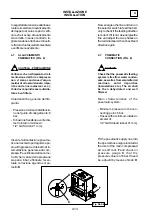
INFORMAZIONI SULLA SICUREZZA -
PRATICHE DI LAVORO SICURO
SAFETY INFORMATION -
SAFE WORKING CONDITIONS
3
3.5.
NORME DI SICUREZZA
PER LA MANUTENZIONE
Non permettere alle persone non
autorizzate di riparare od esegui-
re la manutenzione.
Leggere attentamente il Manuale
di istruzione prima di eseguire la
manutenzione della macchina o
dell’impianto.
Non lubrificare, riparare o registra-
re la macchina in lavorazione a
meno che non sia espressamen-
te richiesto nel Manuale di istru-
zione per evitare di essere affer-
rati da parti in movimento.
Prima di effettuare qualsiasi ope-
razione descritta nel paragrafo 7
del presente manuale mettere a
zero l’interruttore generale elettri-
co, il rubinetto di intercettazione
generale dell’aria compressa e
lucchettarli.
Prima di accedere all’interno del-
la macchina da qualsiasi parte ac-
certarsi che gli organi mobili sia-
no fermi.
3.6.
RISCHI RESIDUI
Nonostante l’osservanza di tutte le
norme di sicurezza e l’impiego
della macchina secondo le regole
descritte nel presente manuale, si
possono avere ancora i seguenti
rischi residui:
- contatto con i nastri abrasivi in
movimento e relativi rulli dalle
bocche di carico e scarico pezzi
(specialmente nel caso di lavo-
razione di pezzi di grande spes-
sore).
- contatto con il nastro trasporta-
tore.
3.5.
SAFETY RULES FOR
MAINTENANCE
Never allow unauthorized
personnel to fix or service the
machine.
Carefully read the User’s Manual
before servicing the machine or
the installation.
Never lubricate, fix or adjust the
machine while it is working, unless
this is explicitly requested in the
User’s Manual, not to be caught
by moving parts.
Before carrying out any of the
operations - as provided for in
paragraph 7 of this manual - make
sure the main electric switch and
the main compressed air stop
cock are turned to zero and
padlocked.
Before any operation inside the
machine is carried out, make sure
all movable parts have been
stopped.
3.6.
OTHER DANGERS
The compliance with the safety rules
and regulations relevant to the
machine use, according to the
instructions described herein, is of the
utmost importance, nevertheless
other dangers might arise:
- contact with running sanding
belts
and relevant rollers
from the inlets
loading and un-
loading workpieces (especially in
case of machining of thick
pieces).
- contact with the conveyor belt.
3.9
















































